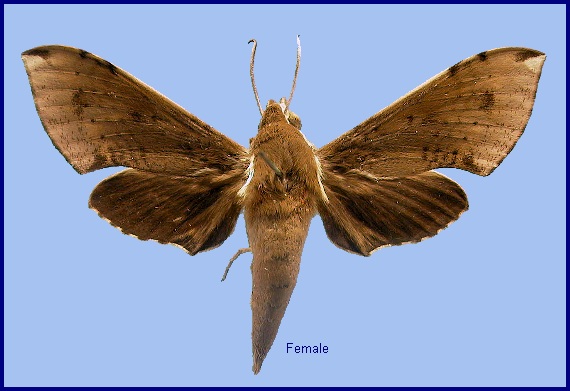
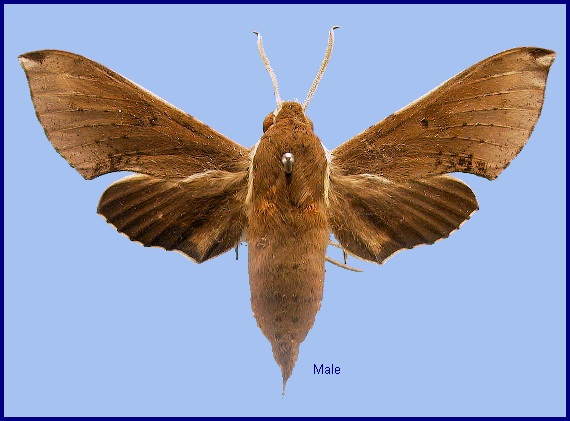
Pergesa mongoliana Butler, [1876] 1875, Proc. zool. Soc. Lond. 1875: 622. Type locality: "Nankow Pass between China and Mongolia" [this is the rail pass through the Great Wall, northwest of Beijing; the 'Mongolia' referred to is Inner Mongolia (Nei Mongol)].
Synonyms. Pergesa mongoliana Butler, [1876].
Synonyms. Rhagastis mongoliana pallicosta Mell, 1922.
Note. Rhagastis mongoliana centrosinaria Chu & Wang, 1980 is a synonym of Rhagastis dichroae Mell, 1922 (Kitching & Cadiou, 2000).
[Further details on this species in Japan, as well as photos of many stages, can be found on Digital Moths of Japan as well as Moths of the southern Shikoku, Japan.]
Wingspan: 47--63mm. Forewing outer margin more convex than in other species of Rhagastis, except Rhagastis lambertoni, which is easily distinguishable by the strongly falcate forewing apex. Forewing upperside with four postmedian lines (or rows of vein dots) that are more distinct posteriorly, beyond which are two small pale brown patches between Rs4 and M1, and M3 and Cu1, with a similar patch at the wing apex; fringe distinctly black and white spotted. In some specimens, the outer postmedian area is buff-coloured near the costal and inner margins, as in Rhagastis acuta, Rhagastis aurifera and Rhagastis velata. Forewing underside with brown submarginal band dilated posterior to vein M2, mostly reaching the basal area. Hindwing underside without a small black discal spot. Labial palp segment 1 apical cavity vestigial; segment 2 about as long as broad, not narrowed to base. Metanotum with a conspicuous tawny patch at each side. Upperside of abdomen without a pair of lateral golden stripes. Outer row of forebasitarsal spines doubled and trebled. Female similar to the male, but with broader wings and paler ground colour; patterns of the forewing and hindwing more faded (Jiang et al., 2024).
In the male genitalia, harpe slender, somewhat sigmoid. Phallus intermediate between Rhagastis velata and Rhagastis aurifera; the left process more slender and multidentate near the proximal edge; the right process long, also multidentate at and near the proximal edge, especially near the apex.
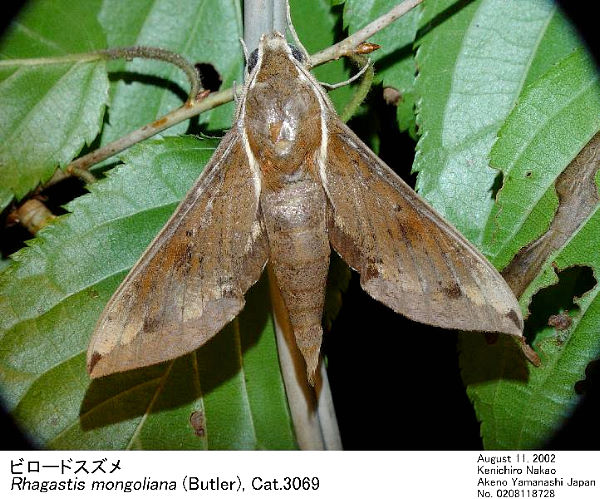
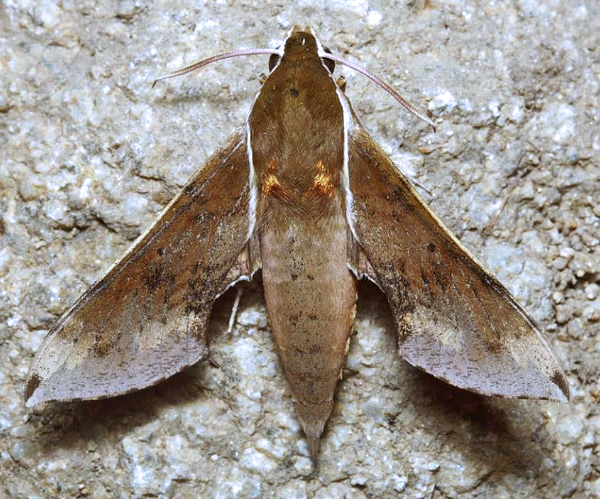
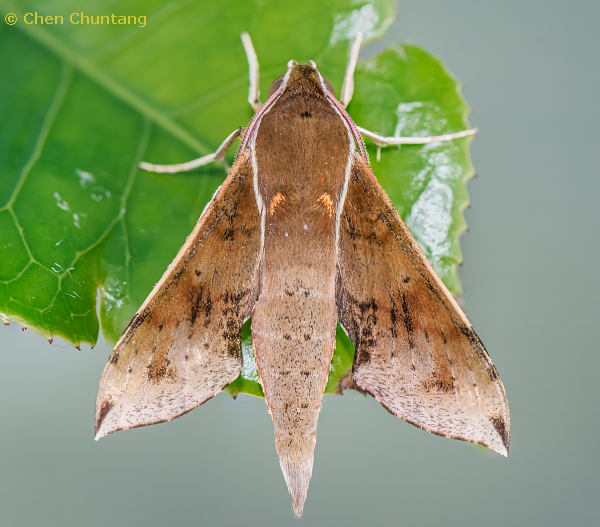
A woodland species in the Russian Far East, with females active from 23.10h until 01.30h, males from 00.20h until 02.30h (Izerskiy, 1999b).
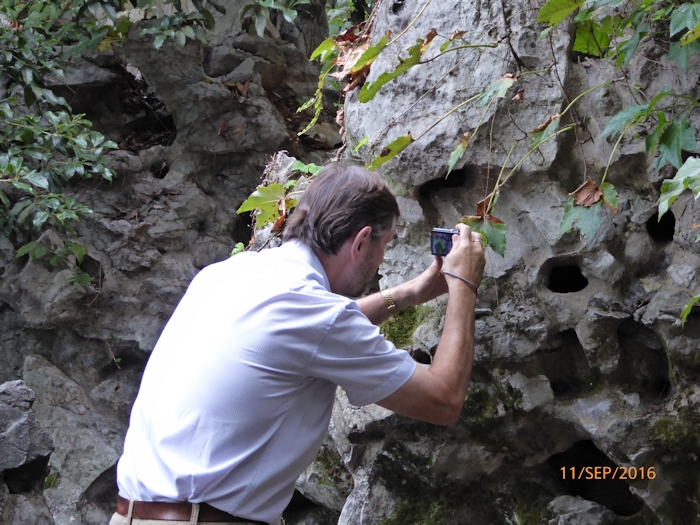
China: v-viii (Jiangxi); 2.v (Hubei); 21-24.v (Zhejiang); 25.v (Shanghai); 29.v-2.vi (Hunan); 20.vi (Beijing); 24.vi.-11.vii (Zhejiang); 10.viii (Fengning, north of Beijing); 14.viii (Zhejiang); 15.viii (Anhui); 20.viii (Hubei). South Korea: 12.vii. Japan: 1.v-10.vii (Yakushima); 15.v-27.vi (Honshu; Kyushu; Shikoku); 15.vii-31.viii (Takushima; Honshu); 3.viii (Shikoku). Russia: 22.vi-20.vii (Khabarovskiy Krai); 22.vi-1.viii (Primorskiy Krai).
In northeastern China, there are two generations a year, with adults flying between late April and August (Yang, 1978). Larvae are usually found in June and September (Chu et al., 1979).
Park et al. (1999) give early May until late August as the flight period in Korea.
OVUM: 1.5 x 2.00mm.
LARVA: Full-fed 47--84mm.
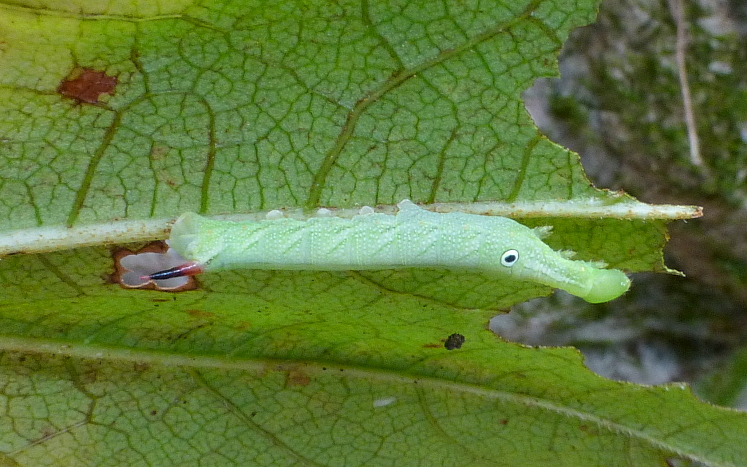
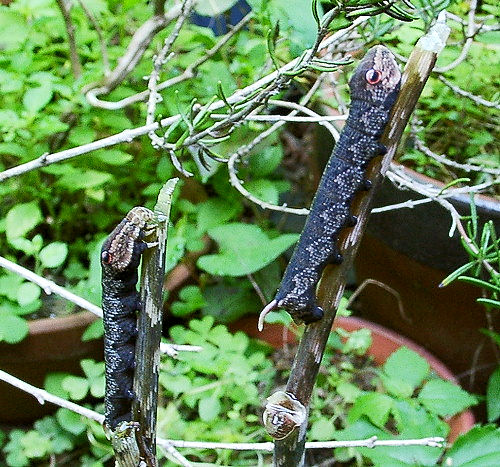
PUPA:

Larval hostplants. Recorded in China on Berberis, Cayratia/Causonis, Impatiens, Polygonum, Parthenocissus tricuspidata and Vitis (Mell, 1922b; Yang, 1978; Chu & Wang, 1980). Records on Hedera nepalensis var. sinensis (Yang, 1978) and Viburnum macrocephalum (Wang, 1992) are certainly erroneous.
Recorded on Taiwan from Impatiens walleriana, Arisaema ringens and Psychotria serpens.
Recorded in Japan on Causonis japonica [syn. Cayratia japonica], Impatiens balsamina (Nozakai & Miyata, 1989), Zantedeschia aethiopica and Parthenocissus tricuspidata.
Recorded in Korea on Impatiens balsamina and Galium verum var. asiaticum (Park et al., 1999).
Recorded from the Russian Far East on Vitis amurensis (Izerskiy, 1999b; Koshkin et al, 2021).
Recorded elsewhere on Cissus, Damnacanthus, Galium, Oenothera and Parthenocissus.
Ichneumonidae: Amblyjoppa cognatoria (Smith, 1874); Tachinidae: Exorista sorbillans (Wiedemann, 1830).
China: Nei Mongol; Heilongjiang; Jilin; Liaoning (Changhai, Dachangshan Island; Benxi, 420m); Hebei; Beijing (Nankow Pass/Xuanhua; Baihua Shan; Badaling National Forest Park); Shanxi (Taiyuan); Qinghai (Nangqian County); Gansu; Henan (Shangcheng); Anhui (Mt. Huang Shan; Jinzhai; Lu'an; Tiantangzhai); Shanghai; Zhejiang (Tianmu Shan; Hangzhou; Kuocang Mountain Nature Reserve); Hubei (Lichuan; Luotian County; Yingshan); Sichuan (Kangding; Pengshui); Chongqing (Yintiaoling, 1130m); Yunnan (Zhaotong, 1026m); Guizhou (Maolan, 975m; Leigongshan, 1200m); Hunan (Cili; Yueyang, 1020m; Wailuo; Zhouluo Longtan Scenic Area); Jiangxi (Jiujiang); Fujian (Longqi Shan); Guangdong (Guangzhou; NanLing National Forest Park); Guangxi (Dayaoshan, 1120m); Hainan (Wuzhishan, 670m).
Taiwan: Taipei (Yangmingshan; Sindian); Kaohsiung Hsien (Shanping); Nantou Hsien (Jenai); Tainan Hsien (Kuantzuling); Taipei Hsien (Fushan; Wulai).
Mongolia: Töv Province.
North Korea: Kangwon Province (Keumgang-san); Kyonggi Province (Gaeseong/Kaesong).
South Korea: Baengnyeong-do & Daecheong-do; Seoul; Kyonggi Province; Kangwon Province; North Chungchong Province; South Chungchong Province; North Cholla Province; South Cholla Province; North Kyongsang Province; South Kyongsang Province; Cheju Province
Japan: Honshu (Tokyo; Nashimoto; Yokohama; Mikaboyama, 750m; Yunotaira Spa; Nii-jima; Ikura; Bushi; Akana; Ohara; Oki Islands (Kadowaki & Kishida, 1977)); Shikoku (Chunan; Shioemachi; Kumakogen); Kyushu (Kitakyushu; Mt. Takakuma); Yakushima (Aikodake; Kuromidake; Kusukawa; Miyanoura); Tsushima (Izuhara).
Russia: Amurskaya (Arkhara area, 4.5 km NW Rachi railway station); Khabarovskiy Krai (Bolshekhekhtsyrskii Nature Reserve, Khabarovsk suburbs; Bikin area; Imeni Lazo area; Anyuysky National Park); Primorskiy Krai (Kaymanovka; Vladivostok; Jankowski Peninsula; Khasan; Primorskiy; Kedrovaya Pad Nature Reserve; Ussuriysk; near Zanadvorovka; Andreevka).
Found throughout central and eastern China, north to Mongolia (Puntsagdulam et al., 2005), Korea, and Amurskaya and Primorskiy Krai, Russia, and east to Taiwan and Japan.
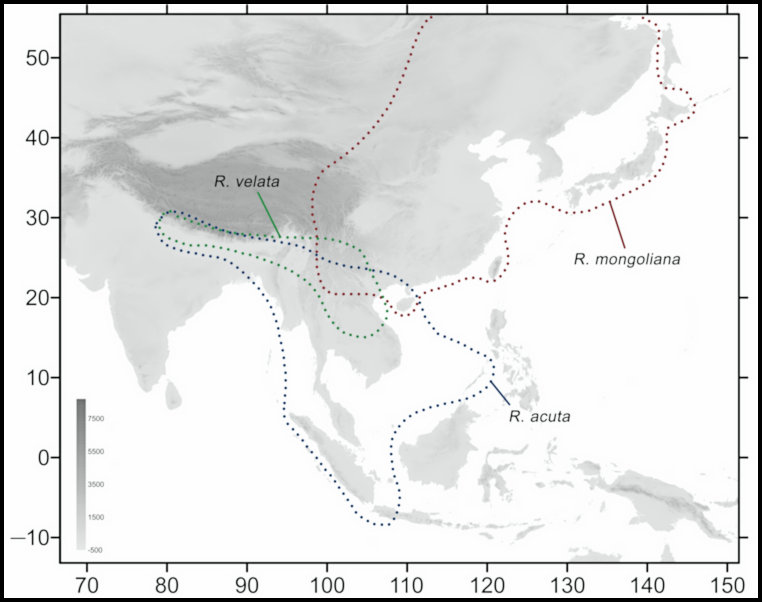
Map: Distribution of three ungrouped species of genus Rhagastis found in China. The blue dotted line indicates the range of R. acuta, the red dotted line indicates the range of R. mongoliana, and the green dotted line indicates the range of R. velata (© Jiang, Wang, Xu, Kitching, Huang, Hu & Xiao, 2024).
Holarctic; eastern Palaearctic region.
 Return to Sphingidae of the Eastern Palaearctic species list
Return to Sphingidae of the Eastern Palaearctic species list